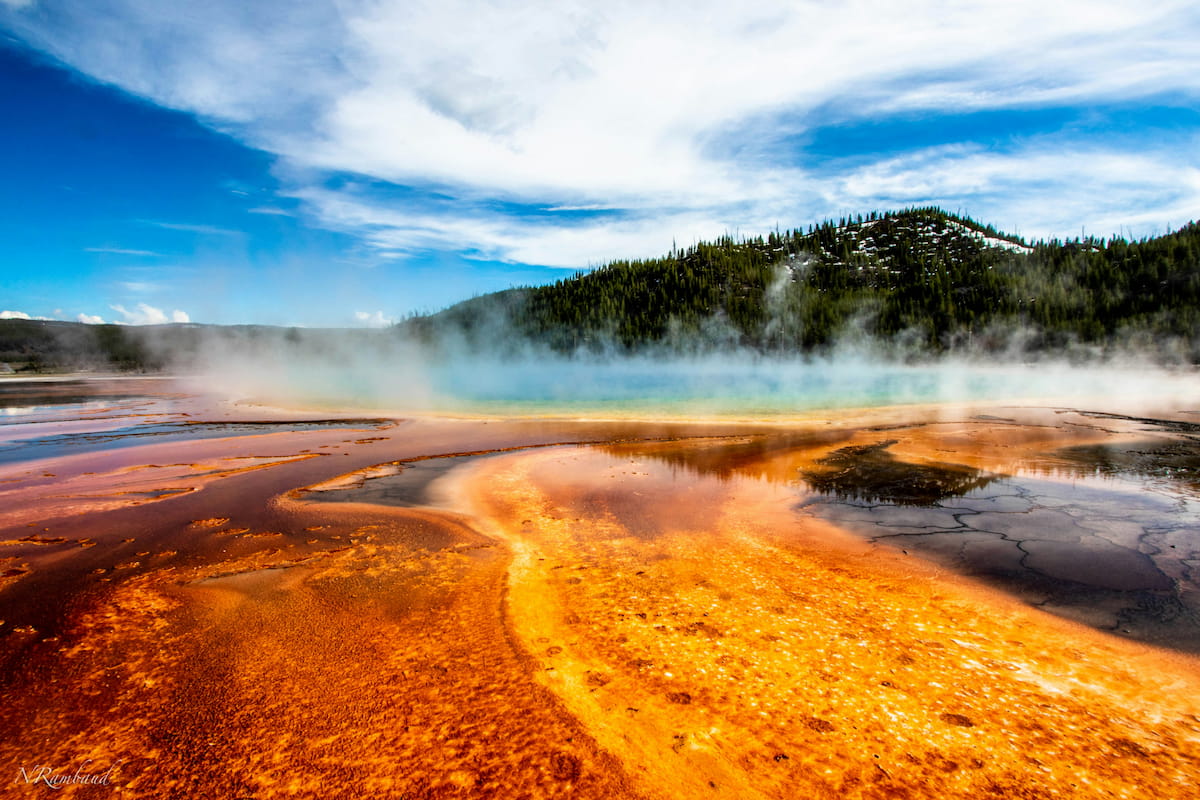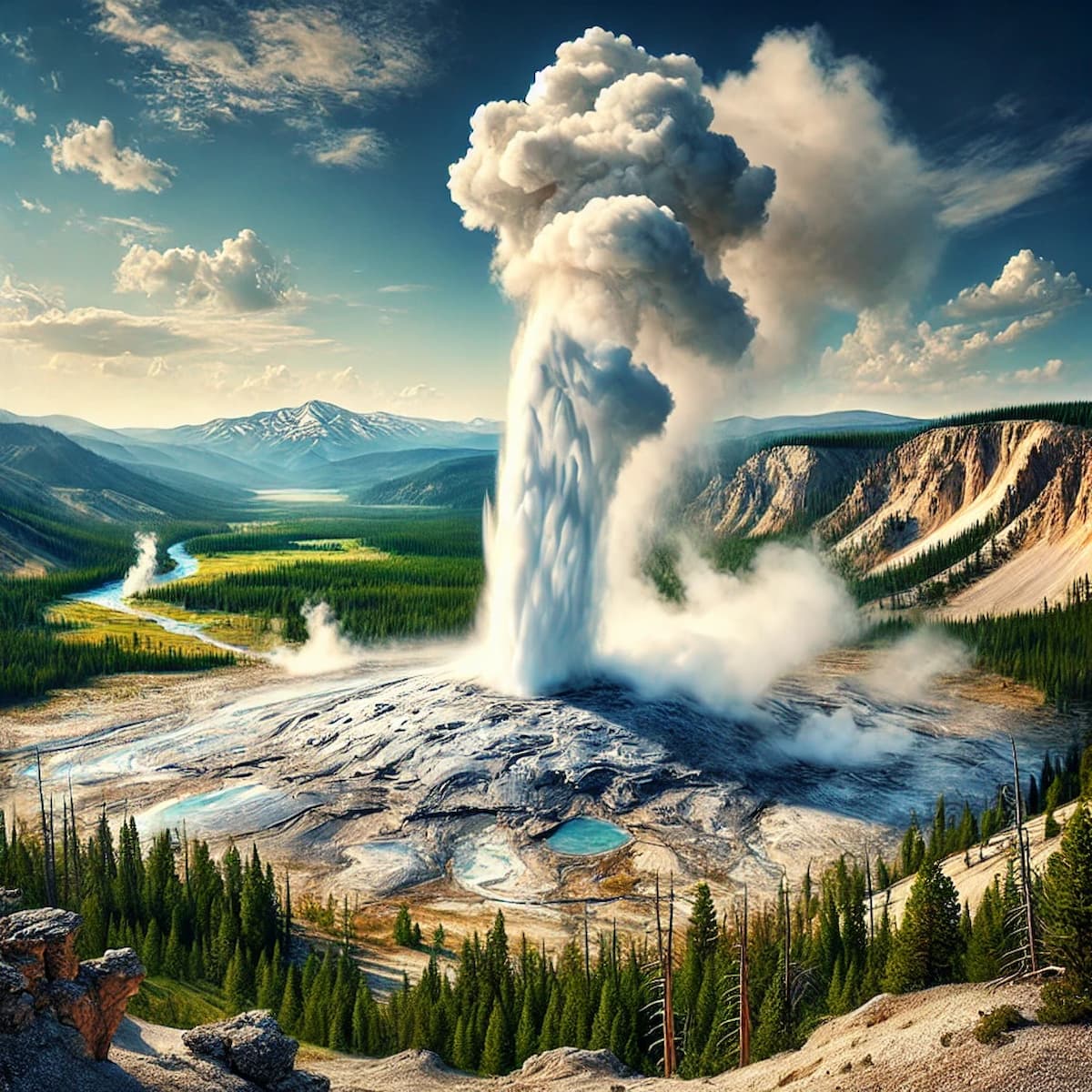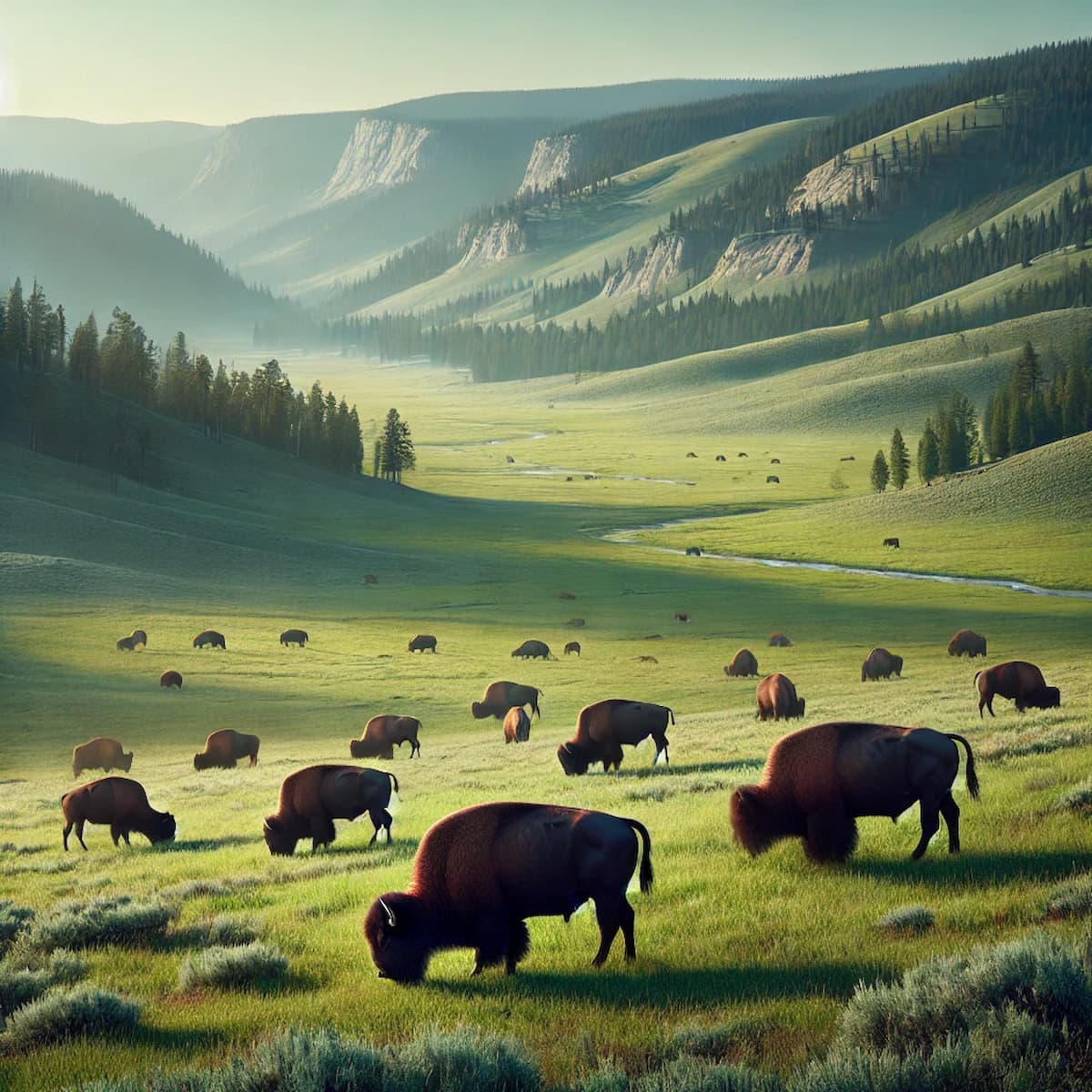
Watch short for this article (5 slides)
Yellowstone: More Than Geysers – Exploring the World's First National Park
Established on March 1, 1872, Yellowstone National Park carries the prestigious title of the world's first national park. Sprawling across over 2.2 million acres (nearly 3,500 square miles) primarily in Wyoming, with extensions into Montana and Idaho, it represents a pioneering concept in conservation – setting aside a vast tract of wilderness for the benefit and enjoyment of the people. Yellowstone is globally renowned for its unparalleled concentration of geothermal features, its remarkably intact ecosystem teeming with iconic North American wildlife, and its dramatic landscapes shaped by volcanic forces and glaciation. It's a place where geology comes alive, wilderness reigns, and the legacy of conservation continues to unfold.

Photo by Nicolasintravel on Unsplash - Old Faithful, an icon of Yellowstone's geothermal wonders.
A Landmark Idea: The Genesis of Yellowstone
While 1872 marks its official designation, the Yellowstone region holds deep significance for Native American tribes, whose presence dates back over 11,000 years. Various groups, including the Crow, Shoshone, Bannock, and Blackfeet, utilized the area for hunting, fishing, gathering, and spiritual purposes, developing an intimate knowledge of its resources and phenomena long before European-American exploration.
Reports from early explorers like John Colter (a member of the Lewis and Clark Expedition who likely passed through in 1807-1808) and subsequent fur trappers described fantastical landscapes of boiling springs and spouting geysers, often met with disbelief back east. Organized explorations, notably the Washburn-Langford-Doane Expedition (1870) and the Hayden Geological Survey (1871), provided systematic documentation, photographs (by William Henry Jackson), and paintings (by Thomas Moran). These expeditions captured the public imagination and fueled concerns that these unique wonders might be exploited for private gain.
Advocates like Ferdinand V. Hayden, recognizing the area's unparalleled value, lobbied Congress. Their efforts culminated in the Yellowstone National Park Protection Act, signed into law by President Ulysses S. Grant. This groundbreaking act set aside the land "as a public park or pleasuring-ground for the benefit and enjoyment of the people," establishing a precedent for national parks worldwide and marking a pivotal moment in conservation history.
The Fiery Heart: Yellowstone's Geothermal Marvels
Yellowstone sits atop one of the world's largest active volcanic systems, often referred to as the Yellowstone Supervolcano. While the term "supervolcano" refers to the potential size of past or future eruptions, the key element driving the park's current geothermal activity is a massive magma chamber lying relatively close (estimated 5-10 miles) beneath the surface. This shallow heat source fuels the park's astounding array of geothermal features – numbering over 10,000, including geysers, hot springs, fumaroles (steam vents), and mudpots. Yellowstone contains more than half of the world's active geysers (approximately 500).
These features require a unique combination of factors:
- Intense Heat: Provided by the underlying magma chamber.
- Abundant Water: Rain and snowmelt percolate deep underground.
- Plumbing System: Fractures and fissures in the rock allow water to circulate, heat up under pressure, and eventually erupt or emerge at the surface.
Iconic Geothermal Features:
- Old Faithful Geyser: Yellowstone's most famous landmark, renowned for its relatively predictable eruptions. While not perfectly regular, park rangers can predict eruption times, typically ranging from 60 to 110 minutes apart, based on the duration of the previous eruption. Each eruption blasts 3,700 to 8,400 gallons of boiling water to heights of 106 to 185 feet.
- Grand Prismatic Spring: Located in the Midway Geyser Basin, this is the largest hot spring in the United States and third largest globally (approximately 370 feet / 110 meters in diameter). Its stunning rainbow colors are created by different species of heat-loving microorganisms called thermophiles (primarily cyanobacteria and archaea). Each color corresponds to a specific temperature gradient: deep blue sterile water in the scorching center (too hot for most life, around 189°F / 87°C), yellows and oranges in cooler zones, and greens further out, where different microbial mats thrive.
- Mammoth Hot Springs: Situated near the park's north entrance, Mammoth presents a dramatically different landscape. Here, hot water rich in dissolved calcium carbonate (from flowing through ancient limestone deposits) rises to the surface. As the water cools and evaporates, it deposits intricate, cascading terraces of white and earth-toned mineral known as travertine. These formations are constantly changing as water channels shift, creating a dynamic, "living" sculpture.

The dynamic travertine terraces of Mammoth Hot Springs are formed by mineral-rich water.
Safety Note: Geothermal areas are extremely dangerous. Scalding water lies just beneath thin, fragile crusts. Visitors must stay on designated boardwalks and trails at all times.
A Sanctuary for Wildlife: The Greater Yellowstone Ecosystem
Yellowstone National Park is the core of the Greater Yellowstone Ecosystem (GYE), one of the largest remaining nearly intact temperate-zone ecosystems on Earth, spanning approximately 22 million acres. This vast area provides critical habitat for a remarkable diversity of wildlife.
The park is home to:
- 67 species of mammals
- Nearly 300 species of birds
- 16 species of fish
- 5 species of amphibians
- 6 species of reptiles
Key wildlife viewing opportunities include:
- American Bison: Yellowstone is the only place in the U.S. where bison have lived continuously since prehistoric times. The park manages the largest free-ranging bison herd (numbering several thousand), often seen grazing in the Hayden and Lamar Valleys or causing "bison jams" on park roads.
- Grizzly Bears and Black Bears: The park provides crucial habitat for grizzly bears (a threatened species) and black bears. Sightings require luck and patience, often occurring at dawn or dusk. Maintaining safe distances (at least 100 yards) is mandatory.
- Gray Wolves: Wolves were controversially extirpated from Yellowstone by the 1920s but were successfully reintroduced in 1995-97. Their return has had profound ecological effects (trophic cascades), impacting elk populations, vegetation growth, and even river dynamics. Lamar Valley is a prime wolf-watching spot.
- Elk (Wapiti): Large herds of elk are common throughout the park. During the autumn rut (mating season, typically September-October), the bulls' loud bugling calls are a characteristic sound.
- Other Sightings: Visitors may also spot mule deer, pronghorn (North America's fastest land animal), bighorn sheep, moose (less common now), coyotes, river otters, bald eagles, osprey, and numerous other species.

The autumn elk rut provides dramatic wildlife viewing and listening opportunities.
Safety Note: Wildlife in Yellowstone is wild. Never approach or feed animals. Maintain safe distances: at least 100 yards (91 m) from bears and wolves, and at least 25 yards (23 m) from bison, elk, and other animals. Carry bear spray and know how to use it when hiking.
Experiencing Yellowstone: Activities and Exploration
Yellowstone offers diverse experiences for millions of visitors annually:
- Scenic Driving: The park's Grand Loop Road provides access to major features, viewpoints, and trailheads.
- Hiking: Over 900 miles of trails range from easy boardwalk strolls around geyser basins (like Upper Geyser Basin near Old Faithful) to challenging multi-day backcountry treks. Popular day hikes include trails along the Grand Canyon of the Yellowstone (offering stunning views of the Upper and Lower Falls) and climbing Mount Washburn for panoramic vistas.
- Wildlife Watching: Patience, binoculars, and timing (early morning/late evening) increase chances. Hayden and Lamar Valleys are renowned hotspots.
- Camping: Twelve developed campgrounds offer reservable and first-come, first-served sites. Extensive backcountry camping requires permits and adherence to Leave No Trace principles.
- Boating and Fishing: Yellowstone Lake, Lewis Lake, and Shoshone Lake offer opportunities for boating (motorized and non-motorized, permits required). Fishing (requires a park permit) targets species like native cutthroat trout (catch-and-release often mandated) and non-native lake trout.
- Photography: The dramatic landscapes, unique geothermal features, and abundant wildlife make Yellowstone a photographer's paradise.
- Winter Activities: Road access is limited in winter, but the park transforms into a snowy wonderland accessible via snowmobile or snowcoach tours, offering unique opportunities for cross-country skiing, snowshoeing, and observing wildlife adapted to the cold.
Stewardship and Challenges: Preserving the Wonder
Managing Yellowstone involves balancing visitor enjoyment with the core mission of preserving its natural and cultural resources unimpaired for future generations. The National Park Service (NPS) oversees complex operations, research, and conservation efforts.
Key challenges include:
- Visitor Impacts: Managing millions of annual visitors to minimize impacts on fragile geothermal areas, wildlife, and infrastructure (traffic congestion, resource strain).
- Climate Change: Affecting snowpack, water availability, wildfire frequency and intensity, vegetation patterns, and wildlife habitats.
- Invasive Species: Controlling non-native plants and animals (like lake trout in Yellowstone Lake, which prey on native cutthroat trout) requires significant effort.
- Wildlife Management: Managing bison populations that roam outside park boundaries, maintaining connectivity for species like grizzly bears across the GYE, and mitigating human-wildlife conflicts.
- Geothermal System Monitoring: The USGS Yellowstone Volcano Observatory constantly monitors seismic activity, ground deformation, and geothermal emissions to understand volcanic hazards.
Conclusion: A Legacy of Wonder and Responsibility
Yellowstone National Park is more than just geysers and bears; it is a living laboratory, a sanctuary for wildlife, a testament to the power of geology, and the birthplace of a global conservation movement. Its dramatic landscapes, unique geothermal phenomena, and vibrant ecosystem offer unparalleled experiences. As the world's first national park, Yellowstone embodies both the foresight of its founders and the ongoing responsibility we share to protect such invaluable natural and cultural treasures from the pressures of the modern world, ensuring its wonders endure for generations yet to come.